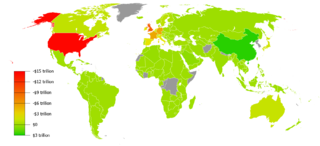Notes
| | This article about the history of Brazil is a stub. You can help Wikipedia by expanding it. |
This article related or pertaining to the economy of Brazil is a stub. You can help Wikipedia by expanding it. |
The samba effect is a nickname for the financial crisis in Brazil in 1999 where there was a 35% drop in the value of the Brazilian real. The effect was caused by the 1997 Asian financial crisis, which led Brazil to increase interest rates and to institute spending cuts and tax increases in an attempt to maintain the value of its currency. [1] These measures failed to produce the intended effect, and the Brazilian government floated its currency against the US dollar, which led to the dramatic decrease in its value. [1] The devaluation also precipitated fears that the ongoing economic crisis in Asia would spread to South America, as many South American countries were heavily dependent on industrial exports from Brazil. [1] These fears resulted in the Brazilian government adopting an austerity program in order to receive a $41.5 billion aid package from the International Monetary Fund and other world lenders. [1]
By the end of 1999, the effect was waning, and the Brazilian economy was beginning to recover. However, unemployment was only slightly lower than before the effect and remained more than twice as high as it was during the late 1980s and early 1990s. [1]
In economics, deflation is a decrease in the general price level of goods and services. Deflation occurs when the inflation rate falls below 0%. Inflation reduces the value of currency over time, but deflation increases it. This allows more goods and services to be bought than before with the same amount of currency. Deflation is distinct from disinflation, a slowdown in the inflation rate; i.e., when inflation declines to a lower rate but is still positive.

The 1997 Asian financial crisis was a period of financial crisis that gripped much of East and Southeast Asia during the late 1990s. The crisis began in Thailand in July 1997 before spreading to several other countries with a ripple effect, raising fears of a worldwide economic meltdown due to financial contagion. However, the recovery in 1998–1999 was rapid, and worries of a meltdown quickly subsided.

In international economics, the balance of payments of a country is the difference between all money flowing into the country in a particular period of time and the outflow of money to the rest of the world. In other words, it is economic transactions between countries during a period of time. These financial transactions are made by individuals, firms and government bodies to compare receipts and payments arising out of trade of goods and services.
The Mexican peso crisis was a currency crisis sparked by the Mexican government's sudden devaluation of the peso against the U.S. dollar in December 1994, which became one of the first international financial crises ignited by capital flight.

The 1998–2002 Argentine great depression was an economic depression in Argentina, which began in the third quarter of 1998 and lasted until the second quarter of 2002. It followed fifteen years of stagnation and a brief period of free-market reforms. The depression, which began after the Russian and Brazilian financial crises, caused widespread unemployment, riots, the fall of the government, a default on the country's foreign debt, the rise of alternative currencies and the end of the peso's fixed exchange rate to the US dollar. The economy shrank by 28 per cent from 1998 to 2002. In terms of income, over 50 per cent of Argentines lived below the official poverty line and 25 per cent were indigent ; seven out of ten Argentine children were poor at the depth of the crisis in 2002.
Foreign exchange reserves are cash and other reserve assets such as gold held by a central bank or other monetary authority that are primarily available to balance payments of the country, influence the foreign exchange rate of its currency, and to maintain confidence in financial markets. Reserves are held in one or more reserve currencies, nowadays mostly the United States dollar and to a lesser extent the euro.
The Convertibility plan was a plan by the Argentine Currency Board that pegged the Argentine peso to the U.S. dollar between 1991 and 2002 in an attempt to eliminate hyperinflation and stimulate economic growth. While it initially met with considerable success, the board's actions ultimately failed. The peso was only pegged to the dollar until 2002.

In macroeconomics and economic policy, a floating exchange rate is a type of exchange rate regime in which a currency's value is allowed to fluctuate in response to foreign exchange market events. A currency that uses a floating exchange rate is known as a floating currency, in contrast to a fixed currency, the value of which is instead specified in terms of material goods, another currency, or a set of currencies.
In macroeconomics and international finance, the capital account, also known as the capital and financial account, records the net flow of investment into an economy. It is one of the two primary components of the balance of payments, the other being the current account. Whereas the current account reflects a nation's net income, the capital account reflects net change in ownership of national assets.
A currency crisis is a type of financial crisis, and is often associated with a real economic crisis. A currency crisis raises the probability of a banking crisis or a default crisis. During a currency crisis the value of foreign denominated debt will rise drastically relative to the declining value of the home currency. Generally doubt exists as to whether a country's central bank has sufficient foreign exchange reserves to maintain the country's fixed exchange rate, if it has any.

Financial contagion refers to "the spread of market disturbances – mostly on the downside – from one country to the other, a process observed through co-movements in exchange rates, stock prices, sovereign spreads, and capital flows". Financial contagion can be a potential risk for countries who are trying to integrate their financial system with international financial markets and institutions. It helps explain an economic crisis extending across neighboring countries, or even regions.
Economic collapse, also called economic meltdown, is any of a broad range of bad economic conditions, ranging from a severe, prolonged depression with high bankruptcy rates and high unemployment, to a breakdown in normal commerce caused by hyperinflation, or even an economically caused sharp rise in the death rate and perhaps even a decline in population. Often economic collapse is accompanied by social chaos, civil unrest and a breakdown of law and order.
A financial crisis is any of a broad variety of situations in which some financial assets suddenly lose a large part of their nominal value. In the 19th and early 20th centuries, many financial crises were associated with banking panics, and many recessions coincided with these panics. Other situations that are often called financial crises include stock market crashes and the bursting of other financial bubbles, currency crises, and sovereign defaults. Financial crises directly result in a loss of paper wealth but do not necessarily result in significant changes in the real economy.
"La Década Perdida" of Latin America is a Spanish term used to describe the economic crisis suffered in Latin America during the 1980s, which continued for some countries into the 1990s. In general, the crisis was composed of unpayable external debts, taxes, and volatile inflation and exchange rates, which in the majority of the countries in the region were fixed.

The Russian financial crisis began in Russia on 17 August 1998. It resulted in the Russian government and the Russian Central Bank devaluing the ruble and defaulting on its debt. The crisis had severe impacts on the economies of many neighboring countries.

The economic history of Brazil covers various economic events and traces the changes in the Brazilian economy over the course of the history of Brazil. Portugal, which first colonized the area in the 16th century, enforced a colonial pact with Brazil, an imperial mercantile policy, which drove development for the subsequent three centuries. Independence was achieved in 1822. Slavery was fully abolished in 1888. Important structural transformations began in the 1930s, when important steps were taken to change Brazil into a modern, industrialized economy.
A sovereign default is the failure or refusal of the government of a sovereign state to pay back its debt in full when due. Cessation of due payments may either be accompanied by that government's formal declaration that it will not pay its debts (repudiation), or it may be unannounced. A credit rating agency will take into account in its gradings capital, interest, extraneous and procedural defaults, and failures to abide by the terms of bonds or other debt instruments.
The 1998–99 Ecuador economic crisis was a period of economic instability that resulted from a combined inflationary-currency crisis, financial crisis, fiscal crisis, and sovereign debt crisis. Severe inflation and devaluation of the sucre led to President Jamil Mahuad announcing on January 9, 2000 that the U.S. dollar would be adopted as the national currency. Poor economic conditions and subsequent protests against the government resulted in the 2000 Ecuadoran coup d’état in which Jamil Mahuad was forced to resign and was replaced by his Vice President, Gustavo Noboa.

Currency war, also known as competitive devaluations, is a condition in international affairs where countries seek to gain a trade advantage over other countries by causing the exchange rate of their currency to fall in relation to other currencies. As the exchange rate of a country's currency falls, exports become more competitive in other countries, and imports into the country become more and more expensive. Both effects benefit the domestic industry, and thus employment, which receives a boost in demand from both domestic and foreign markets. However, the price increases for import goods are unpopular as they harm citizens' purchasing power; and when all countries adopt a similar strategy, it can lead to a general decline in international trade, harming all countries.
The Panic of 1930 was a financial crisis that occurred in the United States which led to a severe decline in the money supply during a period of declining economic activity. A series of bank failures from agricultural areas during this time period sparked panic among depositors which led to widespread bank runs across the country.